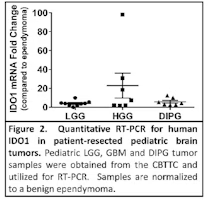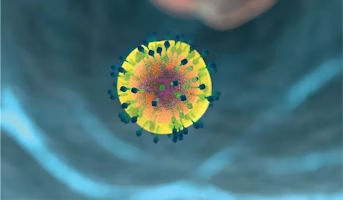PDTM-10. Novel RNA-Targeting Strategy for Treating T Cell-Driven Immunosuppression in Human Diffuse Intrinsic Pontine Glioma

Abstract
PURPOSE: Our laboratory’s work in adult high-grade glioma has discovered, a therapeutically-targetable pathway through the inducible expression of indoleamine 2,3 dioxygenase 1 (IDO1). IDO1 is an immunosuppressive enzyme that metabolizes tryptophan (Trp). The premise of our project is to delineate the role of T-cell-driven IDO1 expression in human DIPG, and to develop the therapeutic potential for inhibiting human IDO1 with novel, specific, small inhibitory (si)RNA oligonucleotides.
METHODS
Gene expression for human IDO1, T-cell specific, CD3e, and the proinflammatory cytokines, IFNγ and IFNb, were investigated among surgically-resected pediatric brain tumor specimens obtained from the Childhood Brain Tumor Tissue Consortium (CBTTC). IDO1 and CD3e were also explored in a novel, humanized DIPG mouse model (NSG-SGM3-BLT), by injecting SF8628 into the brain stem. Humanized mice were either untreated or depleted for human CD4+ and CD8+ T cells. In vitro analysis included unique patient-derived DIPG cell lines, stimulated with human IFNγ, and analyzed for IDO1 mRNA and protein levels, with and without the addition of IDO1 siRNA.
RESULTS
IDO1 expression is normally low in cultured human DIPG, but rapidly induced by IFNγ. Analysis of surgically-resected human pediatric brain tumor specimens confirms the association between IDO1 levels and the co-expression of IFNγ and IFNb. Strikingly, human T cells directly increase human IDO1 expression in intracranial DIPG, while our siRNA specifically decreases IDO1 mRNA, protein and enzyme activity/levels. DISCUSSION: The poor prognosis of children with DIPG, combined with the lack of effective therapies, emphasizes the importance of understanding immunosuppressive IDO1 and its potential therapeutic value. These data also confirm that, immunotherapies aimed at enhancing T cell effector functions in DIPG patients, also need to consider resulting effects on intratumoral IDO1-mediated immunosuppression. Our ongoing work aims to weaponize our novel IDO1-targeted siRNA for in vivodelivery, and for adjuvant treatment in DIPG patients receiving immunotherapy.
related
Resources
Project

Data
Completed
Immunotherapeutically-targeting IDO1 in Pediatric High-grade Glioma
Research into adult glioblastoma has revealed a relationship between heightened levels of enzymes that suppress the immune system and a lowered survival rate. Researchers are using the Pediatric Brain Tumor Atlas to explore this relationship in pediatric high-grade pediatric brain cancer.
HGG

Derek Wainwright
Project

Specimen
Completed
Exploration of IDO1 as a Therapeutic Target in Pediatric Central Nervous System Tumors
Recent work points to the enzyme IDO1 as a high value target for the treatment of adult glioma. Researchers will analyze samples provided by the Children’s Brain Tumor Network to determine whether IDO1 could serve as a therapeutic target for pediatric brain tumors as well.
Medulloblastoma, HGG, LGG, Ependymoma, DIPG

Rishi Ramesh Lulla